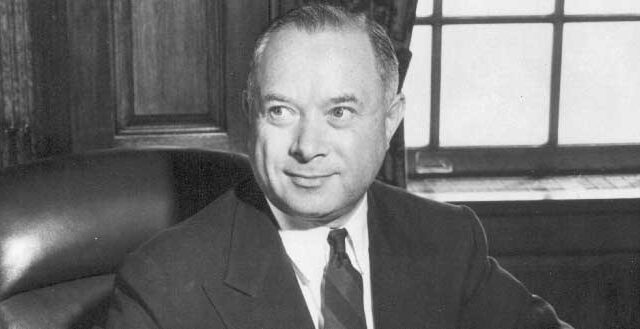One morning in 1906 a 15-year-old Russian immigrant arrived at the New York Herald’s headquarters looking for work. After walking into the main lobby he approached the first man he saw and announced that he wanted a job at the newspaper. Unbeknownst to the immigrant, the man worked for the Commercial Cable Company, which leased a first-floor office from the Herald. Fortunately, the telegraph company was looking for a messenger boy and hired young David Sarnoff, beginning his transformation from an aspiring journalist into the man who created commercial broadcasting.
Sarnoff (1891–1971) proved a model employee, teaching himself Morse code after business hours. Fired later that year for refusing to work on Jewish holidays, he then parlayed his telegraphy experience into a job at the Marconi Wireless Company, where he studied electrical engineering and befriended the company’s namesake, Italian inventor Guglielmo Marconi. In the years preceding America’s entry into World War I, he rose through the ranks at Marconi, earning a reputation for his creative ideas.
His superiors ignored these suggestions, but after Marconi Wireless was acquired by the newly formed Radio Corporation of America (RCA) in 1919, Sarnoff had a chance to make his ideas come to life. As the company’s general manager, he persuaded RCA’s chairman to invest in radio research. In 1921 he spurred public interest by broadcasting a boxing match live to an unprecedented 300,000 listeners. RCA’s late entry in the home-radio market might have doomed the company’s chance for success if not for Sarnoff’s crackdown on competitors’ unauthorized use of RCA-patented radio components, a move that led to skyrocketing profits and his eventual promotion to company president and then chairman.
As other companies cut research budgets during the Great Depression, Sarnoff funneled RCA’s patent royalties into its laboratories and shifted its focus from radio to the newly emerging field of television. Realizing that the complexities behind such an innovation were beyond the reach of any one inventor, he expanded the corporation’s research staff to include hundreds of scientists. His competitors, including General Electric and AT&T, were already exploring the electronic transmission of moving images, and Sarnoff was determined to be first to see it through.
Sarnoff publicly announced his success at the 1939 World’s Fair, hailing it as the beginning of regularly scheduled black-and-white commercial television broadcasts (despite there being only 100 to 200 privately owned television sets in the greater New York area at the time). The RCA-owned National Broadcasting Company (NBC) beamed a speech given at the fair by Franklin Delano Roosevelt, the first such televised presidential talk. But black-and-white was only the first step, and RCA eventually developed an all-electronic color-TV system, as opposed to its competitors’ mechanical system of rotating color filters.
By the 1950s Sarnoff, nicknamed “the General” after coordinating news coverage of the D-Day invasion of Europe, had earned a reputation as a technological visionary, always able to anticipate the latest electronic innovation. His commitment to long-term research was central to the development of modern broadcasting, as well as the electron microscope and the first liquid-crystal displays (an essential step toward the creation of flat-panel televisions). In 1951 RCA’s main research facility in Princeton was renamed in Sarnoff’s honor. Shortly after, in 1954 commercial color broadcasting began—on NBC. Sarnoff had broken into the news business in full color.
1900
David Sarnoff immigrates to the United States from Russia, along with his mother, Leah, and his brothers, Lew and Morris.
1912
As an employee of the Marconi Wireless Company, Sarnoff monitors transmissions from the Titanic following its collision with an iceberg in the North Atlantic.
1929
Sarnoff oversees RCA’s purchase of the Victor Talking Machine company and its most famous trademark: Nipper, the dog.
1939
Sarnoff publicly announces the success of moving-picture transmission at the World’s Fair in New York.
1944
Sarnoff earns the rank of brigadier general after coordinating communications for the Allied invasion of Europe.
1954
Commercialized color-television broadcasting begins on the RCA-owned NBC network.




